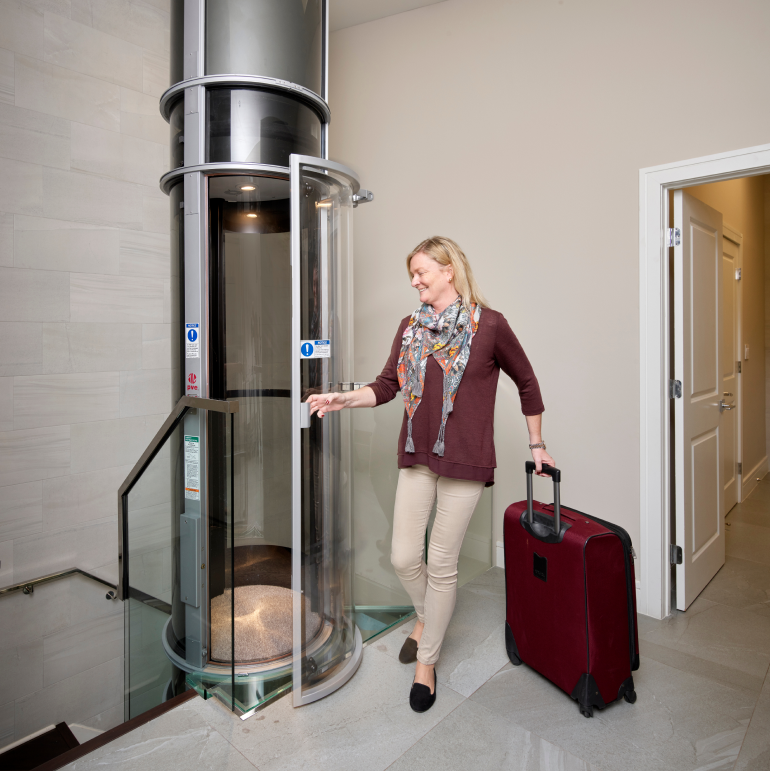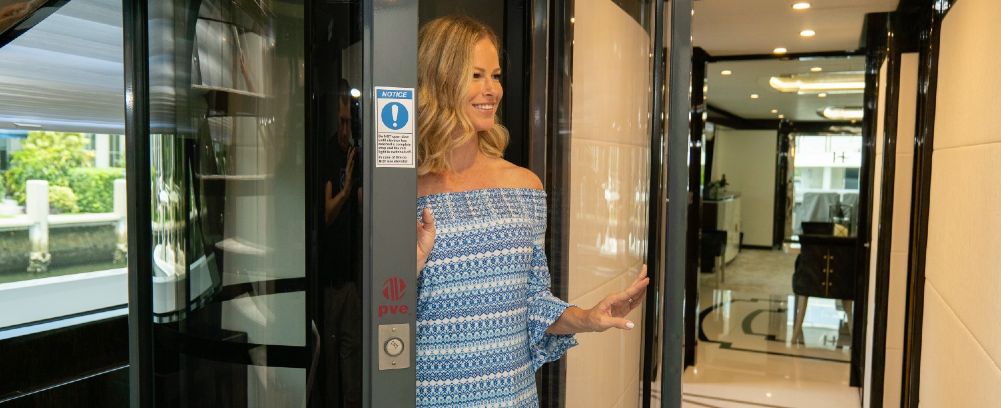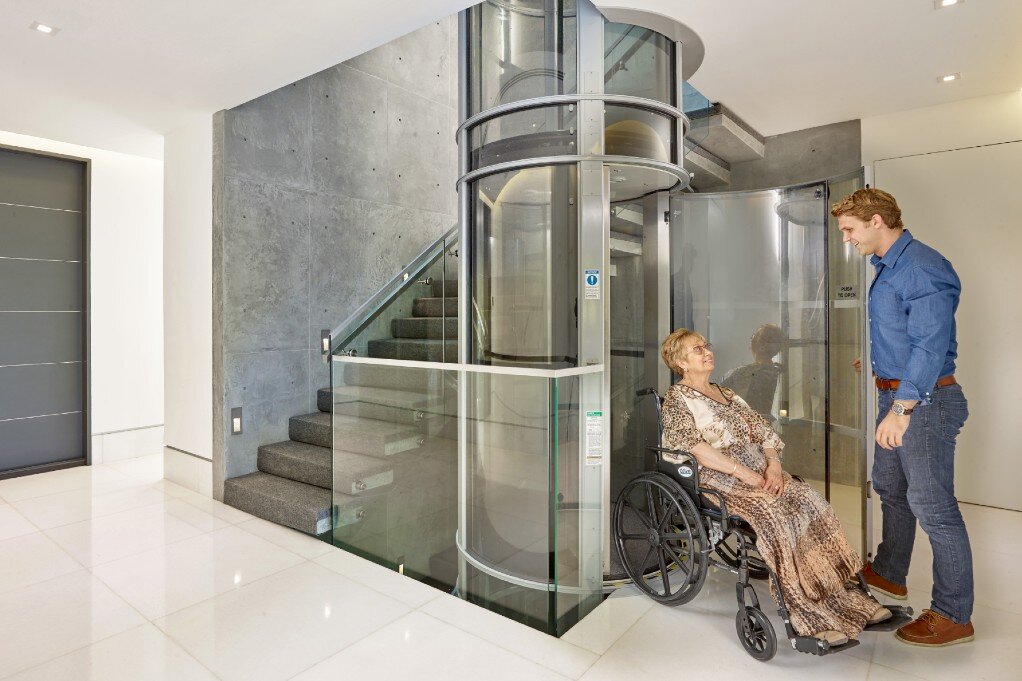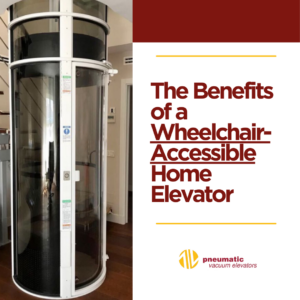Living in a multi-story home offers undeniable advantages – spacious living areas, stunning views, and perhaps even a private rooftop terrace. However, the charm can quickly fade when faced with the daily chore of lugging groceries, laundry, or furniture up and down flights of stairs. This is where residential cargo lifts come in, transforming your multi-level dwelling into a haven of convenience and accessibility.
What is a Residential Cargo Lift?

Unlike a passenger elevator, a residential cargo lift is specifically designed to transport goods and possessions within your home. These lifts typically feature a platform or basket that moves vertically along a guided track system. They are available in various configurations, capacities, and styles to seamlessly integrate into your existing architecture.
Benefits of Installing a Residential Cargo Lift
Beyond the obvious advantage of eliminating back-breaking stair climbing, residential cargo lifts offer a plethora of benefits:
- Enhanced Accessibility: For individuals with limited mobility or those carrying heavy items, a cargo lift eliminates the physical strain and potential safety hazards associated with stairs.
- Improved Convenience: Effortlessly transport groceries, laundry baskets, luggage, and even bulky furniture between floors, saving time and energy.
- Increased Functionality: Turn your basement into a usable living space or utilize your upper floors for storage without the burden of stairs.
- Boosted Home Value: A cargo lift can be a significant selling point for potential buyers, particularly those considering future accessibility needs.
- Space Optimization: Modern residential cargo lifts often have a compact footprint, minimizing the impact on your living space.
Types of Residential Cargo Lifts
Choosing the right cargo lift for your home depends on several factors, including space availability, budget, and intended use. Here’s a breakdown of the most common types:
- Enclosed Wheelchair Lifts: These fully enclosed lifts offer the highest level of safety and comfort for users with mobility limitations. They comply with accessibility codes and provide a smooth, secure ride.
- Vertical Platform Lifts: Also known as VPLs, these versatile lifts feature an open platform that can accommodate various cargo sizes. They are ideal for transporting groceries, luggage, and furniture.
- Dumbwaiters: These small, enclosed lifts are perfect for transporting lightweight items like groceries, dishes, or laundry between floors. They have a limited capacity and platform size.
- Pneumatic Vacuum Lifts: Utilizing a vacuum tube system, these innovative lifts offer a sleek and silent operation for smaller items. They require minimal installation space and are visually unobtrusive.
Key Considerations When Choosing a Residential Cargo Lift
- Weight Capacity: Carefully assess the types of items you plan to transport and select a lift with a sufficient weight capacity. Consider future needs as well.
- Platform Size: Choose a platform size that can comfortably accommodate your intended cargo. Remember, a larger platform might necessitate a bigger lift system.
- Lift Height: Ensure the lift travels the full height required to reach all desired floors in your home.
- Door Options: Consider the type of door you prefer, such as swinging, sliding, or bi-folding doors, based on available space and aesthetics.
- Power Source: Residential cargo lifts can be powered by electricity, hydraulics, or pneumatics. Choose the option that best suits your needs and budget.
- Safety Features: Look for essential safety features like emergency stop buttons, overload protection, and door interlocks.
- Noise Level: Consider the noise level of the lift, especially if it’s installed in a frequently used living area.
- Aesthetics: Modern residential cargo lifts come in a variety of styles and finishes to complement your home’s décor.
- Local Regulations: Check for any building codes or permits required for installing a residential cargo lift in your area.
Installation Process for Residential Cargo Lifts

Installing a residential cargo lift typically involves the following steps:
- Consultation: Contact a reputable cargo lift company to discuss your needs and receive a customized quote.
- Site Assessment: A qualified technician will visit your home to assess the space, determine the optimal lift location, and identify potential installation challenges.
- Permitting: The company will assist you in obtaining any necessary permits from your local building department.
- Installation: Experienced professionals will install the cargo lift according to manufacturer’s specifications and local codes.
- Testing and Training: The lift will be thoroughly tested for functionality and safety. You’ll receive comprehensive training on its operation and maintenance.
Cost Considerations for Residential Cargo Lifts
- Dumbwaiters: $3,000 – $5,000
- Pneumatic Vacuum Lifts: $5,000 – $10,000
- Vertical Platform Lifts: $8,000 – $15,000
- Enclosed Wheelchair Lifts: $12,000 – $20,000+
Additional factors that can influence the price include:
- Customization: Special finishes, platform modifications, or custom door styles might increase the cost.
- Installation Complexity: Factors like the required lift height, existing electrical wiring, and structural modifications can impact installation costs.
- Location: Labor rates and permit fees may vary depending on your geographic location.
Remember: When comparing quotes, prioritize reputable companies with a proven track record and ensure they include all installation costs and necessary permits in their pricing.
Maintaining Your Residential Cargo Lift
Regular maintenance is crucial for ensuring the safe and efficient operation of your residential cargo lift. Follow the manufacturer’s recommended maintenance schedule, which typically includes:
- Visual Inspections: Regularly check for any signs of wear and tear, loose components, or damage.
- Lubrication: Lubricate moving parts according to the manufacturer’s instructions.
- Safety Checks: Test emergency stop buttons, door interlocks, and overload protection features periodically.
- Professional Service: Schedule professional maintenance checks at recommended intervals, typically annually or biannually.
By adhering to these guidelines, you can ensure your cargo lift continues to operate smoothly and reliably for years to come.
Finding the Right Residential Cargo Lift Company
Selecting a reputable and qualified company for your cargo lift installation is critical. Here are some tips:
- Research and Compare: Obtain quotes from multiple companies with experience in residential lift installations.
- Check Credentials: Verify the company’s licensing, insurance, and certifications.
- Review References: Ask for references from past customers and contact them to inquire about their experience.
- Warranty and Service: Ensure the company offers a comprehensive warranty on the lift and provides reliable maintenance services.
Don’t hesitate to ask detailed questions about the installation process, warranty coverage, and available service options.
FAQ: Residential Cargo Lifts
Q: Are residential cargo lifts safe?
A: Reputable companies offer cargo lifts with robust safety features like emergency stop buttons, overload protection, and door interlocks. Additionally, proper installation and regular maintenance enhance safety.
Q: Can I install a residential cargo lift myself?
A: It’s highly recommended to have a qualified professional install your cargo lift. Installation involves electrical work, structural considerations, and ensuring code compliance.
Q: How much ongoing maintenance does a residential cargo lift require?
A: Maintenance requirements vary depending on the lift type. Typically, it involves regular visual inspections, lubrication, and periodic professional service checks. Refer to the manufacturer’s instructions for a detailed maintenance schedule.
Q: Will a residential cargo lift increase the value of my home?
A: Absolutely! A cargo lift can be a significant selling point, particularly for potential buyers considering future accessibility needs or those with multi-story homes.
Q: Can a residential cargo lift be installed outdoors?
A: Some cargo lifts are specifically designed for outdoor use. These lifts typically have weather-resistant materials and coatings. Consult with a qualified professional to determine if an outdoor lift is suitable for your application.
Q: What are the noise levels of residential cargo lifts?
A: Modern cargo lifts are designed with noise reduction in mind. Hydraulic lifts tend to be quieter than electric models. Pneumatic vacuum lifts offer the quietest operation.
Q: Can I customize a residential cargo lift?
A: Yes, many companies offer customization options such as platform size, door styles, and finishes to complement your home’s décor.
Q: How long does it typically take to install a residential cargo lift?
A: Installation time varies based on the lift type, complexity, and any necessary structural modifications. Generally, it can take anywhere from a few days to a week.
By carefully considering your needs, researching different lift options, and choosing a reputable company for installation, a residential cargo lift can transform your multi-story home into a haven of convenience and accessibility for years to come.








